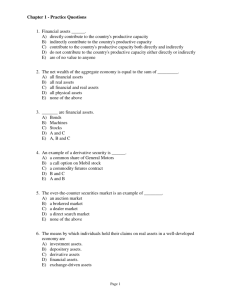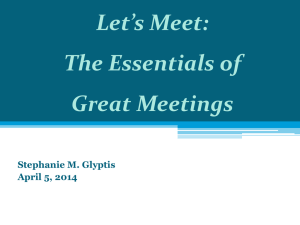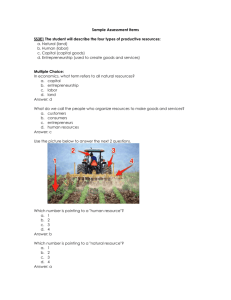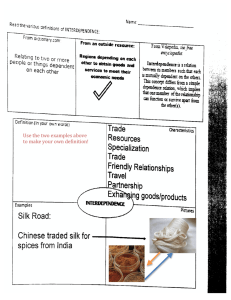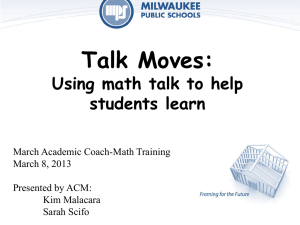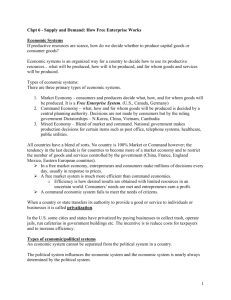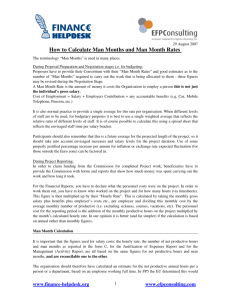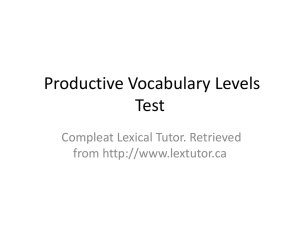Click here to view my full lesson plan
advertisement
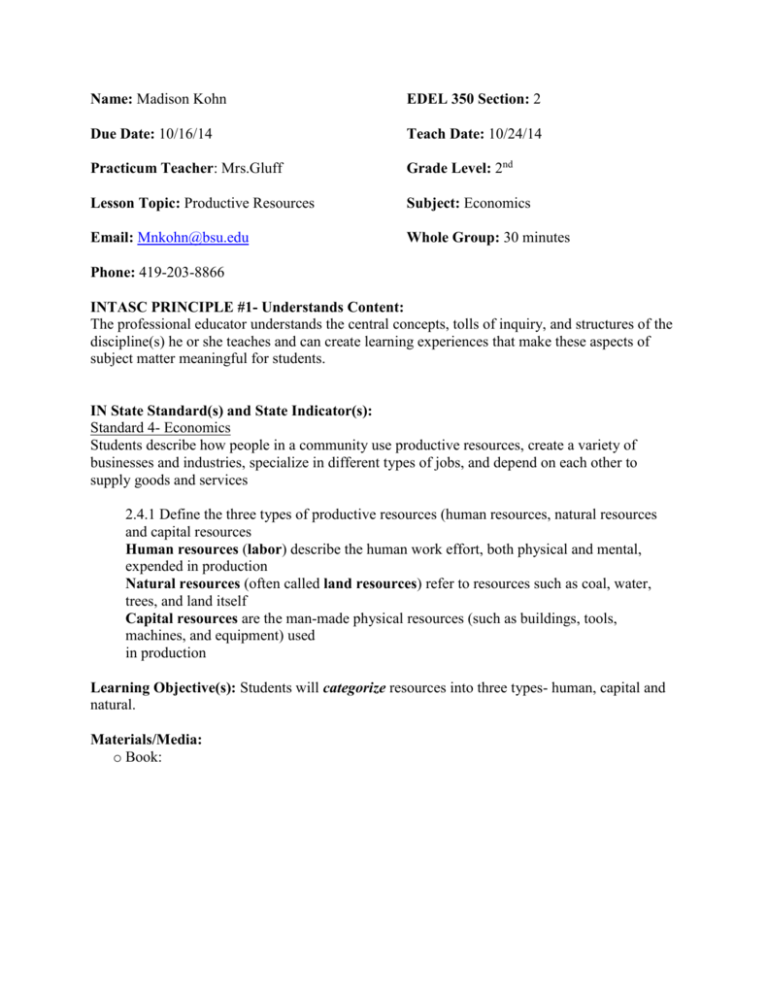
Name: Madison Kohn EDEL 350 Section: 2 Due Date: 10/16/14 Teach Date: 10/24/14 Practicum Teacher: Mrs.Gluff Grade Level: 2nd Lesson Topic: Productive Resources Subject: Economics Email: Mnkohn@bsu.edu Whole Group: 30 minutes Phone: 419-203-8866 INTASC PRINCIPLE #1- Understands Content: The professional educator understands the central concepts, tolls of inquiry, and structures of the discipline(s) he or she teaches and can create learning experiences that make these aspects of subject matter meaningful for students. IN State Standard(s) and State Indicator(s): Standard 4- Economics Students describe how people in a community use productive resources, create a variety of businesses and industries, specialize in different types of jobs, and depend on each other to supply goods and services 2.4.1 Define the three types of productive resources (human resources, natural resources and capital resources Human resources (labor) describe the human work effort, both physical and mental, expended in production Natural resources (often called land resources) refer to resources such as coal, water, trees, and land itself Capital resources are the man-made physical resources (such as buildings, tools, machines, and equipment) used in production Learning Objective(s): Students will categorize resources into three types- human, capital and natural. Materials/Media: o Book: Paulsen, G. (1995).The tortilla factory. o Markers,Crayons,Pencils o Youtube video- https://www.youtube.com/watch?v=0PgP0dXAGAE o Productive Resource Sort Flap Book Peanut Butter Jelly-Bread template Motivation: The teacher will begin with verbally asking if they have ever thought about where the objects in the room come from? How about the shoes you’re wearing, who made them, how did they get to the store? Goal For the Learner: “ Boys and girls today we are going to learn about productive resources and by the end of this lesson you are going to be able to define three different kinds of resources found in your everyday life.” Procedure: New Information o The teacher will introduce the topic by reading a portion of the book Tortilla Factory. The book will be projected so that the entire class can view the story. During this reading the teacher will interact with the students asking them questions and allowing for choral conversation. Possible Questions to ask during reading: What do you think they are making? What resource is needed in order for the corn to grow? (Water.) Have you ever used any of these resources? o The teacher will write three terms on the board: Natural Resources- refer to resources such as coal, water, trees, and land itself Explain that natural resources are often considered land and gifts of nature. They are made without humans and used by producers to make things. What are some examples of natural resources? ( land,water,trees, oil and sunlight) What are some natural resources used in making milk? (cows, land) What are some natural resources used at the school or by you everyday? (land, sunlight, water) Capital Resources- Capital resources are the man-made physical resources (such as buildings, tools, machines, and equipment) used in production. Explain that capital resources are the tools, equipment, and buildings used to make other goods and services. Every good used over and over again to make other goods and services is called a capital resource. Discuss the following: • What are some examples of capital resources? (factories, computers, robots, hammers, desks, and chairs.) • What are some capital resources used in baking a cake? (Mixer, spoon, bowl, baking pan, oven, cooling racks.) • What are some capital resources used at school? (school building, desk, chairs, rulers, textbooks, and computers.) Human Resource- Human resources (labor) describe the human work effort, both physical and mental, expended in production Explain that human resources are the quantity and quality of human effort directed toward producing goods and services. All of the people who produce the goods and services we consume are called human resources. Discuss: What are some examples of human resources? (Doctors, barbers, sales clerks, and teachers.) What human resources are used at school? (Teachers, custodians, secretaries, and principals.) o Teacher will show youtube video: https://www.youtube.com/watch?v=0PgP0dXAGAE after the video teacher will revisit the three terms on the board and define them asking the students to apply what they learned in the video to the definitions. o The teacher will then revisit the book Tortilla Factory and create a T chart on the board for all the students to see it will have three columns labeledNatural,Capital,Human. Each student will have a post it note where they will write something from the book that they remember and decide which of the three columns it would go under- Natural, Capital or Human. The teacher will dismiss students to the board by seating pods, and allow students to place their sticky note under the chosen category. Teacher will choose random items placed on the board and discuss with the class to see it they agree with the placement of the item. “Do we think that this belongs here, why or why not?” Check for Understanding o The teacher will observe the students during the guided practice checking for understanding while circulating the room. The teacher will ask students what kinds of resources are in the classroom, at their homes and around them. Where would some of the items you have discovered be placed on the board under which column- Natural, capital or human? o Questions, Cues Advance Organizers Modeling: Next we are going to do an activity where we get to test our knowledge, we are going to work together and play a game with productive resources. The teacher will show students who their group members are and model that they will stay in their pod seating for the activity. “Each group is going to get a bag of resource cards, both pictures and words which you will place under the correct column on the resource mat I am holding.” The teacher will then use a card and ask students if they know where this card should go and why? “I will glue the card just like this underneath the correct column”. Guided Practice: o During this activity you will work as a group. The teacher will pair students up by seating pods groups will have 5-6 students in each. Within the group each student will be assigned a role 1) glue person 2) clean up (2 students) 3) scribe 4) checker 5) speaker/question asker. Once the students are in groups, they will be given the Productive resources sort cards. Each group will receive a mixture of productive resources both pictures and words. The students will work together to place the cards underneath their resource map, which has three columns-natural, human and capital. Students will use glue to paste their cards under the resource that they think is appropriate. Each group will be given a key to check their answers with once finished. The learners that are excelling will be given a blank card to create their own resource and place it in the correct column on the resource map. Students who are having difficulty will be encouraged to look at the handout, which defines each column on the resource map. Cooperative Learning Practice Application: o Next you will create an image for each of the three productive resources. Students will be given a flap book. Students will be expected to label all three flaps – Human, Capital and Natural. Students will then draw an image that is appropriate for each productive resource. Non-Linguistic Representations Accommodations: For the high ability students they will be allowed to go one step further with write a sentence using their chosen resource. Students who are having difficulty will be pictures to choose from to glue onto their flap book instead of creating their own image. Modeling: I was working on my own flap book and I choose to do a firefighter for my human resource, a tractor for my capital resource and the ocean for a natural resource. Each of you will draw and color if you choose a resource for each of the webs as I did. Closure: The teacher will ask the students if they can tell me something that they learned today about resources that they didn’t know before we began the lesson. Closing Questions: What are some natural resources used in producing the vegetables we eat? Think about the capital resources used to make a cake? What do we call the human resources that bake bread? “Now that we have learned about resources you will know can classify the objects around you in everyday life” Evaluation of Student Learning: o The teacher will observe the students while constructing their flap book to detect if the students have mastered the objective of the lesson. After the students completed the graphic organizer, the teacher will collect them and assess them individually using a rubric. The teacher will complete the rubric for each student and give the information the classroom teacher after assessing. Rubric: Name: Given the flap book, students are able to illustrate an image appropriate for each resource-Natural, Human and Capital. Room for improvement All three of the necessary components of the definition card were missing. Emerging Mastery Two of the necessary components of the definition card were missing. All three components of the definition card were correctly completed. Extension Activity: Provide students with a peanut butter and jelly sandwich cut out. Students will decorate their sandwich and then label a capital, human and natural resource they would use to make this sandwich if they were making one for a customer. Students will then share their sandwiches with other students. Annotated Bibliography: Informational: o Website- www.edconlink.com Productive resources Retrieved from: http://www.econedlink.org/interactives/index.php?iid=191 o This website was able to define the productive resources for the teacher, and also provided ways to apply the concepts to students. It allowed for both teacher and student resources on the subject. Landry, R. (1996). Understanding economics 3:productive resources. o This book is located on amazon and allowed for me to understand the economics before creating my lesson plan. Instructional o Website- kindseconposters.com The tortilla factory (2005). Retrieved from: http://www.kidseconposters.com/literature-connection/productive-resources/thetortilla-factory/ o This website was a great source for activities to implement the usage of the children’s book and apply the knowledge of all three productive resources into real life application. o Textbook- Bauer, K.Drew,R. (1992). Alternatives to worksheets: Motivational reading and writing activities across the curriculum. Creative Teaching Press, Inc. o Mrs.Varner provided this instructional book. This book inspired my lesson extension activity by providing a way to assess students other than providing a test or a worksheet. I used this resource to create the idea for the graphic organizer and illustration option for students to be assessed. Other ResourcesTeachers Pay Teachers http://www.econedlink.org/lessons/index.php?lid=457&type=educator
